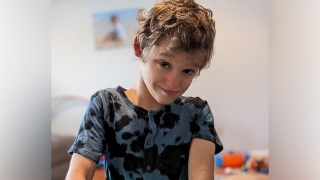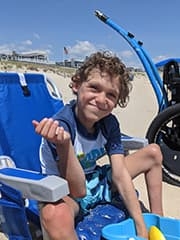Evan’s Story: Deep Brain Stimulation to Treat Complex Movement Disorders
Published on
Published on
There was no “book” Ellen could refer to for medical guidance on her son, Evan, who has a rare genetic mutation. So, she created the book, keeping a journal on his health for most of his 12 years of life. Her insights, plus an innovative approach to therapeutic intervention from a devoted care team at Children’s Hospital of Philadelphia, has led to a life-changing transformation for Evan.
 Learning she was pregnant with her son Evan “was a blessing,” says Ellen, who had previously been told she wasn’t able to have children.
Learning she was pregnant with her son Evan “was a blessing,” says Ellen, who had previously been told she wasn’t able to have children.
After Evan was born, he struggled to hit developmental milestones. He was diagnosed with failure to thrive and, at 6 months of age, began early intervention.
As a medical professional who works in a surgeon’s office, Ellen felt Evan’s health issues weren’t adding up. Though he had been born a little early, at 35 weeks, he had been in the normal range for birthweight, at almost 6 lbs.
“They kept telling me he was going to catch up, but he wasn’t. He wasn’t walking or talking,” she says. “I knew something wasn’t right.”
She took Evan to see specialists at a hospital near their home in Tom’s River, N.J. Eventually, they met with a geneticist who performed a microarray analysis. The test revealed that Evan has a rare mutation in the RPL10 gene. But what that meant was unclear.
“No one could tell me what it was,” says Ellen, of the genetic mutation. “He was the only person that had it. His whole life we have been doing everything by trial and error.”
When Evan was 4, he suddenly began to experience significant health issues. He got illness after illness, from pneumonia to bronchitis, and was in and out of the hospital constantly. He also began to suffer from neurological events. Initially they were seizure-like in appearance, but they quickly evolved into involuntary muscle contractions that caused repetitive twisting and jerking movements throughout his entire body.
An epileptologist near the family’s home referred Evan to Children’s Hospital of Philadelphia (CHOP), where he met with an interdisciplinary team of specialists. He was diagnosed with a rare immune deficiency for which he was prescribed medication.
Evan’s evaluation team included Ingo Helbig, MD, a pediatric neurologist in CHOP’s Neuroscience Center and Director of Genomic Science, Benjamin Kennedy, MD, Director of Epilepsy and Functional Neurosurgery at CHOP, and Nivedita Thakur, MD, Medical Director of CHOP’s Movement Disorders Program. This team diagnosed the neurological movements as a rare and progressive form of dystonia. The severity of the dystonia concerned them. The constant contractions twisting Evan’s body were not only incredibly painful, but they also caused hemorrhages across his abdomen, prevented him from being able to swallow and eat, and made it hard for him to breathe at times.
Dr. Thakur has special training in the treatment of children with dystonia. Deep brain stimulation (DBS) is a treatment option for some children with dystonia. However, with Evan’s condition being so rare, he didn’t fit the typical criteria for DBS treatment, and there was no medical literature to support using it in his case.
Dr. Thakur spoke to Ellen about the treatment. She explained that while she couldn’t guarantee it would work, it was the only option available that offered any hope for him. There was the chance some of Evan’s movement issues would respond to DBS and improve, while some wouldn’t. Dr. Thakur reassured Ellen that if they chose to move ahead with the treatment, she and her team would be available to them every step of the way.
“I couldn’t watch my son do this anymore,” says Ellen, of her decision to go ahead with the treatment. “He had no control of his body. He was in major crisis all the time. He would cry for hours because he was in so much pain.”
In November 2021, Evan had a small battery-powered stimulator implanted in his chest; two wires from the stimulator were guided to points in his brain. When the stimulator is adjusted, the wire ends emit an electrical pulse to reduce the symptoms of the dystonia.
The first time Dr. Thakur adjusted the stimulator was “earth-shatteringly amazing,” says Ellen. “It has been life-changing for him.”
Evan can eat again, he can walk in his walker, and he isn’t in agonizing pain anymore. He has monthly follow-up visits with Dr. Thakur, who adjusts the stimulator’s settings to find the optimal charge level and pulse timing to address his dystonia.
“When you have a medically complex child, especially a child that’s so rare and there’s no book or stats to them, you have to find the right team. You need a team that thinks outside the box, and this is that team. ”
 "Dr. Thakur, Dr. Kennedy, and Dr. Helbig went into it with open hearts, like, ‘We’re going to do everything we can for Evan.’ There’s no dollar amount for how much that meant to me. They care about my son as much as I care about him, and that’s rare. I don’t know what I would have done without them,” she adds. “They’ve held my hands through the worst times of my life, telling me we were going to get through it. It’s that teamwork that has made this possible.”
"Dr. Thakur, Dr. Kennedy, and Dr. Helbig went into it with open hearts, like, ‘We’re going to do everything we can for Evan.’ There’s no dollar amount for how much that meant to me. They care about my son as much as I care about him, and that’s rare. I don’t know what I would have done without them,” she adds. “They’ve held my hands through the worst times of my life, telling me we were going to get through it. It’s that teamwork that has made this possible.”
Ellen describes Evan, now 12, as a sweet, active, good-natured, curly haired beach boy who loves being around other people. He regularly gives Dr. Helbig and Dr. Thakur hugs and high fives.
“He is my greatest accomplishment in life,” says Ellen. “He has taught me so much about life. He’s taught me to never sweat the small stuff, that you have more strength than you know, to never take no for an answer, and to never give up. I feel so lucky to have him.”